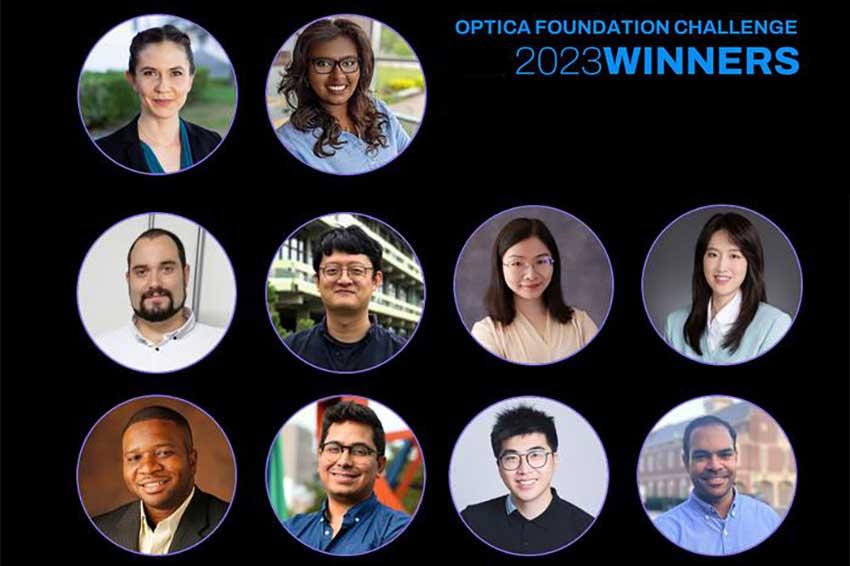Photonic technologies introduce new ways to diagnose menopause and glaucoma
11.12.2023 - Optica Foundation Challenge provides grants for work on a chip-integrated light sensor for early-stage medical intervention.
The 2023 Optica Foundation Challenge funds new women’s health and vision research. Samantha Grist, The University of British Columbia, Canada, and Fernando Zvietcovich, Pontificia Universidad Catolica del Peru, have proposed two separate light-based techniques to solve for challenges in diagnosing health-related concerns, specifically menopause and glaucoma.
“As healthcare diagnostics advance, new opportunities for non-invasive, light-based techniques continue to emerge,” said Alan Willner, chair of the challenge selection committee. “Excitedly, both Dr Grist and Dr Zvietcovich are exploring novel, innovative ways of using light to address issues found in current modalities – precisely the kind of exemplary work the Optica Foundation Challenge strives to address.”
Each research effort is supported by a 100,000 US dollars grant from the Optica Foundation, and Grist and Zvietcovich will use these funds to advance their research in the following ways:
Grist’s silicon PIC approach introduces the potential for quantitative, accurate, data-rich measurements of hormones, with tens to hundreds of biosensors integrated on a single millimeter-scale chip in the future. However, PIC-based biosensor analysis has required costly and bulky systems that limit their applicability in clinical environments – until now. Grist and her team have invented a new sensor architecture that addresses this challenge by applying a tiny, inexpensive laser for readout.
“Our work focuses on validating a portable, low-cost technology for decentralized, multiplexed monitoring of hormone markers in urine,” explained Grist. “We will build a tool that has the potential to drastically improve health and quality of life during the menopausal transition.”
Grist points to a two-fold approach to advance this concept: 1. A rigorous exploration of the new sensor architecture to quantify and optimize its performance; and 2. Assay design to appropriately evaluate hormone biomarkers. In six months, Grist hopes to be at the stage to start actively measuring hormone markers and evaluating the full scope of the application with an interdisciplinary team.
Fernando Zvietcovich, Pontificia Universidad Catolica del Peru, Peru, has proposed the development of a clinical multi-excitation optical coherence elastography system. This system will enable high-resolution structural images of the eye through optical coherence tomography (OCT). At the same time, the system will leverage air and ultrasonic pulses to excite the mechanical waves in the cornea, providing biomechanical information of the eye to help obtain corrected and adjusted intraocular pressure values, thus enabling the detection of normotensive glaucoma (NTG).
“This field of applying OCT with other imaging modalities and excitation sources is really just emerging,” Zvietcovich shared. “We’re measuring properties in the human eye and changes in biomechanics that were not possible to measure before, and we have entered a new dimension with the information that we can now see. We’re in the early stages of new ways to monitor and propose treatments for the eye.”
As a first step, Zvietcovich plans to finalize designs and build a prototype optical coherence elastography system. Once it’s created, he will initiate modeling tests to refine the approach, and ultimately, will take the system into clinical settings. In six months, Zvietcovich expects to have the first expression of the prototype, and ultimately, he plans to hold a preliminary patient study with twenty control patients, twenty patients with NTG, and twenty patients with high-tension glaucoma to generate biomechanically inspired biomarkers of the cornea.
“In the short term, the main benefit of this work will be that it enables researchers to apply these technologies and clinical studies will follow. In the long term, I can see this device in clinics, helping diagnose NTG and other eye diseases more efficiently and cost-effectively. Ultimately, I hope that patients will avoid vision loss because of this research,” Zvietcovich summed up.
Both research initiatives were made possible by grants awarded through the Optica Foundation Challenge. This challenge was designed to engage early-career professionals in out-of-the-box thinking and provide seed money to investigate hypotheses in the areas of environment, health and information. Each of the recipients received 100,000 dollars to explore their ideas and take steps toward addressing critical global issues.
Recipients have begun work on these projects and expect to report initial results later in 2024. For more information and the complete list of 2023 winners, please visit optica.org/foundationchallenge.







